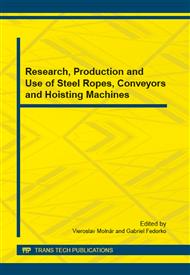p.15
p.22
p.28
p.33
p.39
p.45
p.50
p.55
p.61
Non-Destructive Testing of Steel Wire Rope Transmission Area to Rope End by Magnetic Flux Leakage
Abstract:
At present the need of nondestructive testing of rope bridges state appears often. Modern maintenance trends using non-destructive checking allow to detect the state of these materials in service without breaking their integrity. From the point of view of so far used non-destructive testing methods the area of cable end is not accessible. The magnetic properties research of these materials and the subsequent design of new structures for scanning elements will enable non-destructive monitoring of the state of the ropes steel material of static constructions, especially their anchoring. The article aims to present the results from tracking of the magnetic flux around the cable end and signal runs from particular designed and investigated scanning elements placed above artificial defects created closely to the cable end.
Info:
Periodical:
Pages:
39-44
Citation:
Online since:
October 2014
Authors:
Keywords:
Price:
Сopyright:
© 2014 Trans Tech Publications Ltd. All Rights Reserved
Share:
Citation:


